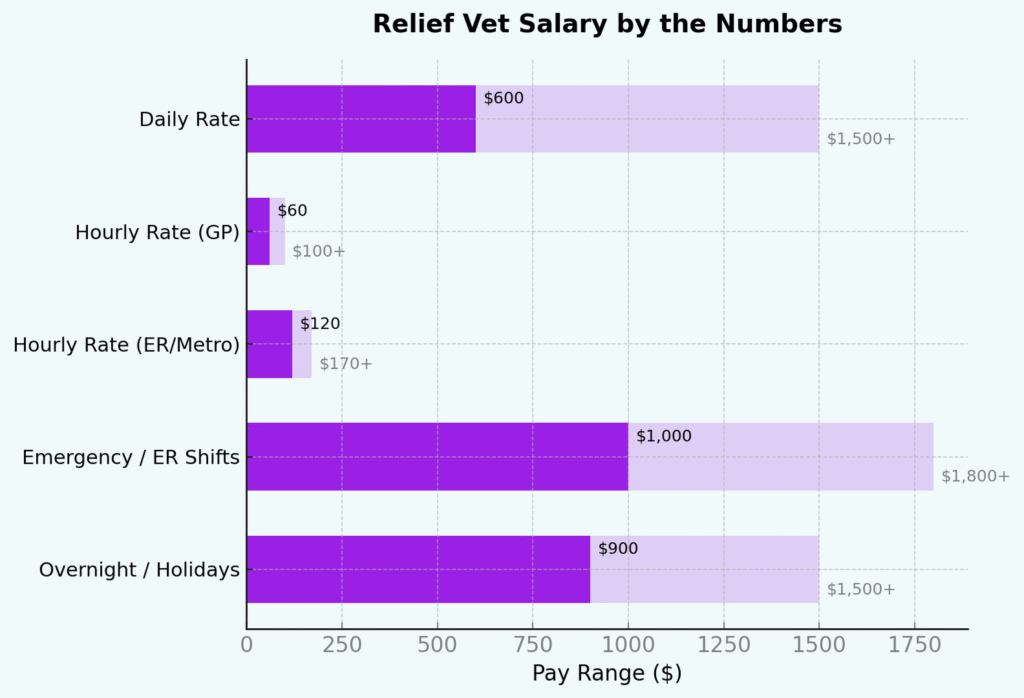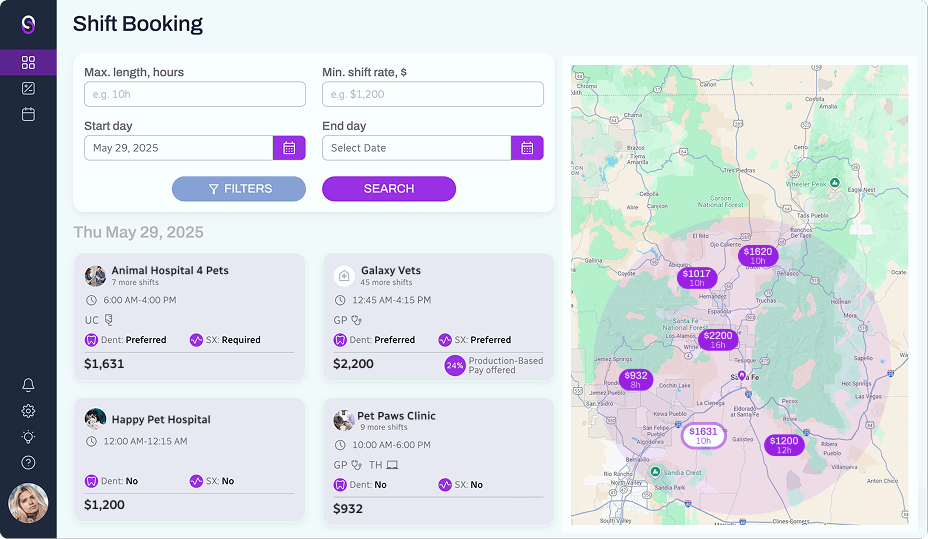
Relief Veterinarian Salary: How Much Do Relief Vets Really Make?
“I heard a relief vet made $1,800 covering a weekend shift.”
It’s the kind of number that stops you mid-scroll, especially if you’re working full-time, juggling back-to-back appointments, and wondering how much longer you can keep this pace.
Relief work tends to spark curiosity for exactly that reason.
To some, it sounds like the dream: higher pay, fewer hours, no office politics.
To others, it feels risky: inconsistent income, no benefits, and a lot of logistics to handle solo.
So which is it?
If you’re here, you’re probably asking what a lot of vets are quietly wondering:
How much do relief vets make, and is it really better than what I’m earning now?
This guide breaks down real earnings for relief vets: typical rates, the factors that influence them, and how they stack up against full-time salaries.
Whether you want more control over your schedule, a sustainable income, or a new career path, you deserve the full financial picture.
Relief Vet Salary by the Numbers
Let’s start with the data: how much does a relief vet make in the U.S.?
The short answer? On average, anywhere from $600 to $1,500 per day — sometimes more, depending on location, shift type, and experience.
But averages don’t tell the whole story. So let’s break it down.
National Averages for Relief Vets
Here’s a look at real-world numbers, pulled from industry data, job boards, and relief vet communities:

| Pay Type | Typical Range | Notes |
| Daily Rate | $600 – $1,500+ | Most common for general practice relief; varies by shift length, region, and demand. ER and holiday shifts often hit the upper end. |
| Hourly Rate | $60 – $100+ (GP), $120 – $170+ (ER/Metro) | Often used for ER, short shifts, or overnight coverage. Premium metro areas can exceed $150/hr, especially for last-minute bookings. |
| Emergency / ER Shifts | $1,000 – $1,800 per shift | Higher clinical intensity and irregular hours mean higher pay. Big cities and specialty hospitals are at the top of the range. |
| Overnight / Holidays | $900 – $1,500+ per shift | Premium pay, especially for short-notice or holiday coverage. Some ER overnights exceed $1,700. |
| High-Cost / Urban Markets | 15–30% above national average | Includes California, New York, DC, Massachusetts, Washington, and other high-demand metros. Reflects higher living costs and strong competition for vets. |
Sources: ZipRecruiter, Indeed, VHMA 2023 Survey, community insights from r/Veterinary and r/veterinaryprofession
🧠 Pro tip: Many experienced relief vets avoid hourly gigs in favor of flat daily rates — fewer surprises, easier billing.
Relief Veterinarian Pay by State
Where you work can make a big difference in what you take home. States with high living costs and strong demand consistently sit at the top of the pay scale. Others, especially in the Southeast, tend to pay less on average.
Here’s a snapshot of average annual and hourly pay for relief vets around the country:
| Rank | State / Region | Avg. Annual Salary | Avg. Hourly Rate | Quick Take |
| 1 | Washington | $187,476 | $90.13 | Urban demand + high living costs = premium rates |
| 2 | District of Columbia | $187,050 | $89.93 | Includes D.C. metro & parts of Maryland/Virginia |
| 3 | New York | $181,092 | $87.06 | NYC metro rates can top $170/hr |
| 4 | Massachusetts | $180,776 | $86.91 | Boston area is a hot market |
| 5 | Alaska | $178,264 | $85.70 | Remote coverage often means higher pay |
| … | U.S. National Avg. | $165,500 | $79.57 | Full-time relief workload equivalent |
| 46 | Louisiana | $141,546 | $68.05 | Higher in New Orleans metro |
| 47 | Georgia | $139,768 | $67.20 | Atlanta > rural areas |
| 48 | Arkansas | $136,875 | $65.81 | Mostly rural mixed-animal work |
| 49 | West Virginia | $128,146 | $61.61 | Limited demand outside small animal |
| 50 | Florida | $123,697 | $59.47 | Large market, but lower clinic fees |
💡 Pro tip: Even in lower-paying states, metro areas, and ER/holiday shifts can bump you well above the averages.
Source: ZipRecruiter — Average Relief Veterinarian Salary by State (2025 data)
W-2 vs. 1099: Don’t Skip This Part
Here’s where the math gets tricky — and where a lot of vets make apples-to-oranges comparisons.
| Category | W-2 Associate Vet | 1099 Relief Vet |
| Base Compensation | $100K–$130K/year | Varies (often higher hourly/day rates) |
| Health Insurance | ✅ Usually included | ❌ Not included |
| Retirement Benefits | ✅ Sometimes offered | ❌ Not included |
| CE + Licensure | ✅ Often reimbursed | ❌ Self-funded |
| Taxes Withheld | ✅ Employer-handled | ❌ Self-managed |
| Write-offs/Deductions | ❌ Limited | ✅ Available |
| Autonomy & Flexibility | ❌ Limited | ✅ High |
Relief vets are self-employed. That often means higher earning potential and more freedom over your schedule, but you’ll be covering your own health insurance, retirement savings, CE, and taxes. With the right planning, those trade-offs can work in your favor.
🧮 Quick math: Four 10-hour shifts a week at $900/day = $187,200/year before taxes and expenses. As a 1099, you’ll owe self-employment taxes and cover your own benefits — so take-home will be lower, though many relief vets still match or beat associate pay while working fewer days.
Find Relief Shifts on Your Terms
Enjoy flexibility, better pay, and total control over your schedule with Serenity Vet.
Real Talk: Is Relief Actually More Lucrative Than Full-Time?
If you scroll vet forums, relief work is either “the best decision I ever made” or “not worth the hassle.”
And here’s the truth most blog posts skip:
Relief work isn’t automatically more lucrative — but it can be, with the right strategy.
Let’s break it down.
📉 Associate Vet Compensation (W-2)
Let’s say you’re a full-time associate earning:
- $115,000/year base salary
- Plus:
- $7,000 in health + dental
- $3,000 CE + license reimbursements
- $4,000 401(k) match
- 2 weeks PTO
- Malpractice + liability insurance
Total comp package: ~$129,000/year, give or take.
It’s steady, predictable, and (if you’re lucky) comes with mentorship and a good team. But it also means you’re locked into clinic hours and culture.
💼 Relief Vet Compensation (1099)
Now imagine you’re doing 4 shifts/week at around $950/day:
- $950 × 4 days × 48 weeks = $182,500 gross
Subtract:
- ~15% self-employment tax — often $25K–$27K before deductions
- $6K–$10K/year for health insurance, CE, licenses, and business expenses
- 2–4 unpaid weeks off for vacation or sick time (already factored in here)
- Some admin time to coordinate everything.
That still puts you in the $145K–$149K net range in many cases — and more if you take premium shifts, increase your rates, or work extra days. In short, relief work can mean:
- More money compared to many associate roles
- Greater control over your schedule
- No built-in benefits unless you arrange them yourself.
What Makes the Difference?
Whether relief pays off comes down to three questions:
- How consistent are your bookings?
Sporadic shifts = income rollercoaster. But with a steady pipeline? Relief can outpace associate pay fast. - How well do you manage the business side?
Do you know your numbers? Track write-offs? Set aside for taxes? Use tools to streamline? If not, your income might leak through the cracks. - What kind of lifestyle do you want?
- Relief: more autonomy, flexibility, potentially higher income
- Associate: more structure, benefits, team support.
There’s no right or wrong, just what fits you best.
The Smart Play?
Even if you’re not ready to go all-in on relief, many vets start by:
- Picking up one shift/week (to test the waters)
- Using relief to supplement income during transitions
- Booking relief while job-hunting or relocating.
You don’t have to burn the boats. You can build your relief income gradually and see how it stacks up for yourself.
Next up: how to actually make it work — without burning out or getting underpaid.
Relief Work Done Right: Maximize Your Income
Relief work can be incredibly rewarding, both financially and professionally, but only if you approach it like a business, not just a side hustle.
This is where many relief vets either thrive… or stall out.
Here’s how to make sure you’re in the first group.
1. Be Strategic About Shift Selection
Not all shifts are created equal. If you’re only taking standard weekday hours at the lowest local rate, you’re leaving money on the table.
- Stack premium shifts: ER, holidays, and overnights = higher pay
- Fill last-minute gaps: Clinics often pay more when they’re desperate
- Work smarter: Aim for clinics with well-trained teams and efficient workflows (fewer headaches = better ROI on your time).
2. Raise Your Rates Over Time
If you’ve got a solid track record, good reviews, and can hit the ground running in any clinic, you’re worth more than the median.
Start with the going local rate, then increase by:
- $50–$100/day after 6–12 months of reliable work
- More for specialties like dentistry, surgery, ultrasound, or ER.
💡 Always frame your rate in terms of value, not just time. Relief vets who can maintain workflow, client trust, and staff morale are worth it.
3. Build Long-Term Relationships
Being reliable, drama-free, and communicative is the ultimate growth strategy.
- Become a go-to for a few anchor clinics
- Book recurring shifts in advance
- Get referred by managers and other vets.
This cuts down on your admin time and lets you lock in steady income without constant hustle.
4. Treat It Like a Business
Relief income is great — but don’t forget, it comes with overhead.
- Track everything (mileage, supplies, CE, subscriptions)
- Set aside 25–30% for taxes
- Consider forming an LLC or S-corp if your income justifies it
- Work with a CPA who understands veterinary relief work.
5. Use Tools That Do the Heavy Lifting
The fastest way to sink your earnings? Spending hours managing emails, contracts, scheduling, and invoicing.
That’s where tools like Serenity Vet come in — streamlining all the logistics, so you can spend your time where it pays.
(Relief work is flexible — your admin shouldn’t be.)
Serenity Vet: Predictable Income Minus the Chaos

If you’ve read this far, one thing’s clear:
Relief work can be profitable — but the logistics can kill the momentum.
You didn’t go to vet school to chase invoices, negotiate rates, or juggle a dozen email threads just to get one shift booked. That’s where Serenity Vet comes in.
We built SerenityVet for relief vets who want:
- Transparent, premium pay
- Fast, reliable payouts
- Smart scheduling tools that prevent burnout
- Access to quality practices that value your time.
Whether you’re testing the waters or going all-in on relief, Serenity Vet makes the process actually work — for your income, your lifestyle, and your sanity.
TL;DR: Is Relief Work the Right Move for You?
Relief veterinary work isn’t a shortcut. It’s not passive income.
But it is one of the most flexible, high-upside paths in veterinary medicine — if you approach it strategically.
Here’s the bottom line:
Relief Work Is a Good Fit If You:
- Want more autonomy over your schedule and workload
- Thrive on variety and adaptability in different clinic settings
- Are comfortable handling your own business logistics (or using relief platforms like Serenity Vet to streamline it)
- Value earning potential and flexibility over traditional stability.
It Might Not Be for You If You:
- Rely heavily on employer-provided benefits
- Prefer consistency and long-term clinic relationships
- Dislike self-employment logistics or managing your own taxes
- Just starting out and need mentorship or structured growth.
Want to Explore It Without Going All-In?
You don’t have to quit your job tomorrow.
Start by:
- Picking up 1–2 relief shifts/month
- Testing rates, commute zones, and clinic types
- Using a platform like Serenity Vet to eliminate friction.
You’ll learn what you like, what you don’t — and whether relief work fits your career, your income goals, and your lifestyle.

